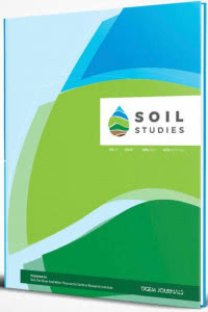The Use of Remote Sensing and Geographic Information System Techniques to Determine Relationships between Land Use and Landform
Digital elevation model (DEM), GIS, land cover, landform, remote sensing, soil formation, , Sayısal yükseklik modeli (SYM), CBS, arazi örtüsü, arazi şekli, uzaktan algılama, toprak oluşumu
Arazi Kullanımı ve Arazi Şekli Arasındaki İlişkilerin Belirlenmesi için Uzaktan Algılama ve Coğrafi Bilgi Sistemi Tekniklerinin Kullanımı
___
- Anderson J R, Hardy E E, Roach J T and Witmer R E (1976). A Land Use and Land Cover Classification System for Use with Remote Sensor Data. U.S. Geological Survey, Professional Paper 964, pp 28, Reston, VA.
- Bayramin I (1998). Integrating Digital Terrain and Satellite Image Data with Soils Data for Small Scale Mapping of Soils. Ph. D. Thesis. Purdue University, Agronomy Department. 121 pages. W. Lafayette, IN 47907
- Brabyn L (1998). GIS Analyses of Macro Landform. Presented at SIRC 98 The 10th Annual Colloquium of the Spatial Information Research Centre, University of Otago, Dunedin, 16-19 November 1998, New Zealand.
- Dikau R, Brabb E E, Mark R M (1991). Landform Classification of New Mexico by Computer. U. S. Dept. of the Interior, U. S. Geol. Survey Report 91-634.
- Hammond E H (1954). Small-scale continental landform maps: Annals of Assoc. of American Geographers 44, p: 33-42
- Helvaci C and Bozkurt S (1994). Geology, mineralogy and petrogenesis of Beypazari (Ankara) granite. Geological Bulletin of Turkey, V. 37, No:2, pp. 31-42.
- Horvath E H, Post D F, and Kelsey J B (1984). The relationships of Landsat digital data to the properties of Arizona range lands. Soil Science Society of America Journal. 48, pp. 1331-1334.
- Jenny H (1980). The Soil Resource; Origin and behavior. Ecol. Studies 37. Springer-Verlag, NY.
- Karadenizli L (1995). Sedimentology of the Upper Miocene Pliocene gypsum series of the Beypazari Basin, west of Ankara, Central Anatolia, Turkey. Geological Bulletin of Turkey, V. 38, No: 1, pp. 63-74.
- Klingebiel A A, Horvarth H D, Moore G W, and Reybold U (1987). Use of Slope, Aspect, and Elevation Maps Derived From Digital Elevation Model Data in Making Soil Surveys. Soil Science Society of America, Soil Survey Techniques, SSSA Special Publication, 20, pp. 77-98.
- Lee K, Lee G B, and Tyler E J (1988). Thematic mapper and digital elevation modeling of soil characteristics in hilly terrain. Soil Science Society of America Journal. 52, pp. 104-1107.
- Moore I D, Gessler P E, Nielsen G A and Peterson G A (1993). Soil attribute prediction using terrain analysis. Soil Science Society of America Journal. 57, pp. 443-452.
- Shovic H and Mantagne C (1985). Application of a statistical Soil-Landscape Model to an Order III Wildland Soil Survey. Soil. Sci. Soc. Am. J. 49, pp. 961-968.
- Siyako F (1983). Geology report of the Beypazari (Ankara) coal Neogenes basin and surrounding area. Mineral Research Institute Report No: 7431. Ankara.
- Smith D W and Verrill W L (1998). Vernal Pool-SoilLandform Relationships in the Central Valley, California. In C.W.
- Witham, E.T. Bauder, D. Belk, W.R. Ferren Jr., and R. Ornduff (Editors). Ecology, Conservation, and Management of Vernal Pool Ecosystems Proceedings from a 1996 Conference.
- California Native Plant Society, Sacramento, CA. pp. 15-23. Soil Survey Staff (1993). Soil Survey Manual. USDA Handbook No: 18. U. S. Government Printing Office, Washington, D. C.
- Soil Survey Staff (1996). Soil Survey Laboratory Methods Manual, Soil Survey Investigation Report, No: 42, USDA, NRCS, NSSC, Washington, D. C.
- Soil Survey Staff (Soil Taxonomy) (1999). A Basic of Soil Classification for Making and Interpreting Soil Survey. U.S.D.A Handbook No: 436, Washington D.C.
- Stoner E R, and Baumgardner M F (1981). Characteristic variations in reflectance of soil. Soil Science Society of America Journal, 45, pp. 1161-1165.
- Su H, Ransom M D, and Kanemasu E T (1989). Detecting soil information on a native prairie using Landsat TM and SPOT satellite data. Soil Science Society of America Journal. 53, pp. 1479-1483.
- Swanson D K (1990). Soil Landform Units for Soil Survey. Soil Survey Horizons, 31, pp. 17-21.
- Thornthwaite C W (1948). An approach to a rational classification of climate. Geographical Review 38, pp. 55-94.
- Tucker C J, Townshend J R, and Goff T E (1985). African Land-cover classification using satellite data. Science, 227 4685, pp. 367-374.
- ISSN: 2146-7072
- Yayın Aralığı: 2
- Yayıncı: Toprak Gübre ve Su Kaynakları Merkez Araştırma Enstitüsü
Analysis of the Spatial Variability of Soil Properties in Different Physiographic Units
Hasan SABRİ ÖZTÜRK, Gönül AYDIN, Mustafa SAĞLAM, Levent ATATANIR, Alper YORULMAZ
Tülay TUNÇAY, İlhami BAYRAMİN, Hasan Sabri ÖZTÜRK, Mümtaz KİBAR, Oğuz BAŞKAN
Yield and Fruit Quality Response of Drip-Irrigated Melon to the Duration of Irrigation Season
Neslihan ŞENGÜL, Osman YILDIRIM, Nilgün HALLORAN, Şeyda ÇAVUŞOĞLU, Evran DOĞAN
